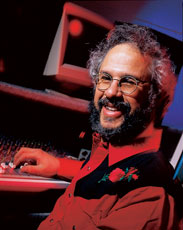|
|
The Chairman of the Boards |
August 1999 |
|
During the past year, I redesigned my entire studio. In order to reduce room noise and clutter, I built an equipment closet, pulled and rerouted every cable, reconfigured the racks, added new signal processors, modified m computer, improved the AC system, and much more. This huge project took quite a while’Äîespecially because I had to fit it in around EM's hectic publishing schedule.
A large part of the redesign was figuring out the best way to rearrange and rewire the myriad gadgets I have accumulated in my studio over the years. In the process, I also realized how frustrated I am with my aging, undersized mixer, which forces me to use several submixers and patch hays to route my many synthesizers, samplers, and processors.
I was tempted to cut down to a few key pieces and get on with making music. After all, you don't always need racks of gear; Mark Hudson (interviewed in "A Room with a Vibe" on p. 72) once recorded a commercial Ozzy Osborne album on a Tascam Portastudio. But as I started reviewing my instruments and recording gear, I realized I couldn't bear to part with most of it.
The solution? Unfortunately for my bank account, what I need is a digital mixing console that has lots of analog inputs and Lightpipe I/O. I could dump the old mixer and submixers and eliminate some outboard gear, which would reduce the amount of cabling. At the same time I could more freely transfer tracks to and from my instruments, processors, MDM, and computer. Furthermore, I already use a computer to control as much of my rig as possible, and most digital mixers would let me automate my entire mix from a sequencer, including tape tracks, EQ, dynamics processing, and perhaps some multi-effects. That's a sweet prospect. So I'm saving for a digital console and contemplating the inevitable: another (much less ambitious) studio redesign.
But which digital console? As of this writing, there are a dozen models for personal-studio and live-performance applications, though a couple are apparently being phased out. Several new ones should he available by the time you read this. Each mixing board has a distinctive "personality" in terms of user interface, features, and connectivity, and the price range is amazing. I've test-driven a few models, but I haven't had extensive experience with them yet.
Therefore, in a selfish display of raw power, I dubbed Associate Editor Jeff Casey "Chairman of the Boards" and assigned him to test ten digital mixing boards, which was no small task. Thanks to his research (see "A Perfect Ten" on p. 38), you and I are in a better position to figure out which consoles would best suit our needs.
Digital mixers are no longer the wave of the future; they're happening now. I am very excited about what they can do for personal studio owners and performing musicians alike. If you aren't fired up about them yet, I think you will be after you have read the Chairman's report. |
